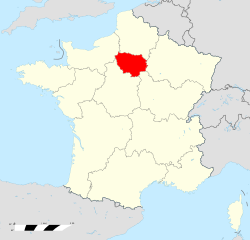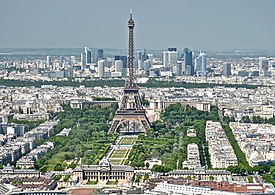
Île-de-France
Administrative region of France / From Wikipedia, the free encyclopedia
Dear Wikiwand AI, let's keep it short by simply answering these key questions:
Can you list the top facts and stats about Île-de-France?
Summarize this article for a 10 years old
The Île-de-France (/ˌiːl də ˈfrɒ̃s/, French: [il də fʁɑ̃s] ⓘ; literally "Isle of France") is the most populous of the eighteen regions of France, with an official estimated population of 12,271,794 residents on 1 January 2023.[1] Centred on the capital Paris, it is located in the north-central part of the country and often called the Paris Region[3] (French: Région parisienne, pronounced [ʁeʒjɔ̃ paʁizjɛn]). Île-de-France is densely populated and retains a prime economic position on the national stage: though it covers only 12,012 square kilometres (4,638 square miles), about 2% of metropolitan French territory, its 2017 population was nearly one-fifth of the national total.[4]
Île-de-France | |
|---|---|
Clockwise from top: western Paris and La Défense in the distance; the Viaduc of Saint-Mammès; the Palace of Versailles; and the UNESCO World Heritage Site of Provins | |
 | |
| Country | France |
| Commune | Paris |
| Departments | |
| Government | |
| • President of the Regional Council | Valérie Pécresse (LR) |
| Area | |
| • Total | 12,012 km2 (4,638 sq mi) |
| • Rank | 13th |
| Population (1 January 2023) | |
| • Total | 12,271,794[1] |
| Demonym | French: Francilien |
| Time zone | UTC+01:00 (CET) |
| • Summer (DST) | UTC+02:00 (CEST) |
| ISO 3166 code | FR-IDF |
| Gross regional product[2] | Ranked 1st |
| –Total | €742 billion (2019) |
| –Per capita | €59,400 (2018) |
| NUTS Region | FR1 |
| Website | www |
The region is made up of eight administrative departments: Paris, Essonne, Hauts-de-Seine, Seine-Saint-Denis, Seine-et-Marne, Val-de-Marne, Val-d'Oise and Yvelines. It was created as the "District of the Paris Region" in 1961. In 1976, when its status was aligned with the French administrative regions created in 1972, it was renamed after the historic province of Île-de-France. Residents are sometimes referred to as Franciliens, an administrative word created in the 1980s. The GDP of the region in 2019 was nearly one-third of the French,[2]: 12 and 5% of the European Union's.[2]: 12 It has the highest per capita GDP of any French region and the third highest of any region in the European Union.[citation needed]
Beyond the city limits of Paris, the region has many other important historic sites, including the palaces of Versailles and Fontainebleau, as well as the most-visited tourist attraction in France, Disneyland Paris. Though it is the richest French region, a significant number of residents live in poverty: the official poverty rate in the Île-de-France was 15.9% in 2015. The region has witnessed increasing income inequality in recent decades and rising housing prices have pushed the less affluent outside Paris.[5]

.jpg)

.jpg)